Scottish Prison Population Statistics: Legal Status, 2019-20
Experimental prison population statistics covering the period 2009-10 to 2019-20, expanding on the previous publication with information about legal statuses, sentences and offences.
4 Custodial Journeys
Examining index offences and associated sentence lengths provides one summary picture of the prison population and how it is changing over time. It also allows insight in to why the prison population has risen in recent years despite crime and the number of individuals entering custody falling. However, summarising the information in this way masks the complexity of the offence profile of those in custody, as well as the complexity of their custodial journeys.
In the previous publication, information on departures from custody was provided[16]. Volumes of departures, liberation types and overall time served were presented, demonstrating that volumes had decreased, that release arrangements had changed, and that time served was increasing over the time period observed. With the newly developed dataset it is possible to explore departures from custody by legal status and to better examine the nature of the custodial ‘journeys’ experienced by individuals.
Section 1 of this report explained that individuals may be held in custody for a number of reasons as per the Criminal Procedure (Scotland) Act 1995 and that the prison population comprises three key groups: the (U)ntried population, the Convicted (A)waiting Sentence population and the (S)entenced population.
Some individuals enter and leave custody having had the same legal status for the duration of their time served/ held. Others enter custody with one legal status and transition to another before leaving. Custodial journeys vary depending on legal status on arrival and whether or not the individual transitions between legal statuses before departing. Exploring the new dataset identifies the following possible custodial ‘journey’ types:
| Journey type | Journey description | Summary notation |
|---|---|---|
| Untried only | Individual enters and departs custody as untried | U__ |
| Convicted awaiting sentence only | Individual enters and departs custody as convicted awaiting sentence | _A_ |
| Untried to convicted awaiting sentence | Individual enters custody as untried, transitions to convicted awaiting sentence and then departs | UA_ |
| Untried to convicted awaiting sentence to sentenced | Individual enters custody as untried, transitions to convicted awaiting sentence, and transitions to sentenced before departing | UAS |
| Untried to sentenced | Individual enters custody as untried and transitions to sentenced before departing | U_S |
| Convicted awaiting sentence to sentenced | Individual enters custody as convicted awaiting sentence and transitions to sentenced before departing | _AS |
| Sentenced only | Individual enters and departs custody as sentenced | __S |
The data held by the Scottish Prison Service provides the legal statuses attributed to individuals in custody and how these change during the time spent in custody. However, it cannot explain why custodial journeys vary in this way.
4.1 Departures by journey type
As discussed in section 2 of this report, arrivals have decreased overall across all legal status types between 2009-10 to 2019-20. This pattern is reflected in the number of departures from custody over the same time period[17]. Table 2 shows the volume of departures and transitions by broad journey type between 2009-10 and 2019-20:
| Journey Types | U__; _A_; UA_ | __S; U_S; _AS; UAS | U_S; _AS; UAS | All | U_S; _AS; UAS |
|---|---|---|---|---|---|
| Year | Remand Departure | Sentenced Departure | Remand Transition[19] & S-Departure | Total Departures | Remand Transition w/o Departure[20] |
| 2009-10 | 8,636 | 8,896 | 3,837 | 21,369 | 2,354 |
| 2010-11 | 8,432 | 8,465 | 3,467 | 20,364 | 2,341 |
| 2011-12 | 8,713 | 8,266 | 3,592 | 20,571 | 2,590 |
| 2012-13 | 7,788 | 8,363 | 3,354 | 19,505 | 2,316 |
| 2013-14 | 7,899 | 8,138 | 3,286 | 19,323 | 2,275 |
| 2014-15 | 7,979 | 7,438 | 3,282 | 18,699 | 2,197 |
| 2015-16 | 7,571 | 7,101 | 3,134 | 17,806 | 2,231 |
| 2016-17 | 6,911 | 6,751 | 2,913 | 16,575 | 2,258 |
| 2017-18 | 6,253 | 6,425 | 2,680 | 15,358 | 2,130 |
| 2018-19 | 6,106 | 5,940 | 2,830 | 14,876 | 2,379 |
| 2019-20 | 6,544 | 5,484 | 2,713 | 14,741 | 2,269 |
| % change 2009-10 to 2019-20 | -24% | -38% | -29% | -31% | -4% |
The table shows that while there have been decreases across each of the departure or transition types, the size of the reduction has varied. Consistent with the findings of increasing numbers of individuals serving longer sentences in section 3 of this report, the greatest percentage decrease has been for departures from the sentenced population.
4.2 Journeys including periods on remand
Looking at completed journey type within each year (2009-10 to 2019-20) we can examine how custodial journeys have changed over time, and, in particular, examine the experience of remand much more closely than previous datasets have allowed.
As per section 2 of this report, remand arrivals (both untried and convicted awaiting sentence) continue to comprise the majority of arrivals to custody from 2009-10 to 2019-20.
4.2.1 Nature of remand journeys
Figure 28 shows the number of completed journeys per year for custodial journeys that begin in remand. There is an overall reduction in the number of remand custodial journeys concluding from 2009-10 onwards, and the broad distribution of journey types in each year remains consistent over time.
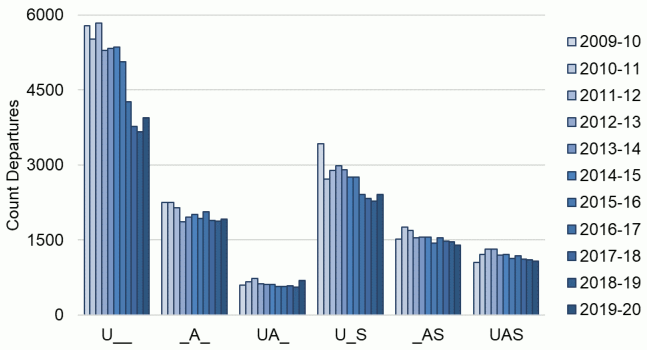
The most commonly completed journey type in each year is ‘untried only’ (U__). The number of completed journeys of this type has fallen substantially (from 5,778 in 2009-10 to 3,939 in 2019-20, a reduction of around 32%), but there is an observable increase in 2019-20. In 2019-20, ‘untried only’ comprised just over one third of all journeys involving time on remand.
The next most common journey type is ‘untried to sentenced’ (U_S), and again there is an overall downward trend in the number of these journeys concluding (from 3,124 in 2009-10 to 2,312 in 2019-20). ‘Convicted awaiting sentence only’ (_A_) is the third most commonly completed journey type, but this has remained at a fairly consistent volume, at or around 2,000 journeys per year since 2009-10. Similar consistencies in volumes over time are observed across the remaining journey types.
Overall, a high volume of custodial journeys that begin in remand result in an individual departing custody straight from remand (6,544 in 2019-20, or 57% of all completed custodial journeys that began in remand). The outcome or destination of these journeys (U__, _A_ and UA_) is explored further in 4.3.1.
4.2.2 Time on remand
Figure 29 shows the median time on remand for individuals by journey type. These statistics include those individuals who completed the remand part of their journey in each year of analysis (even where the sentence was on-going at the end of that period).
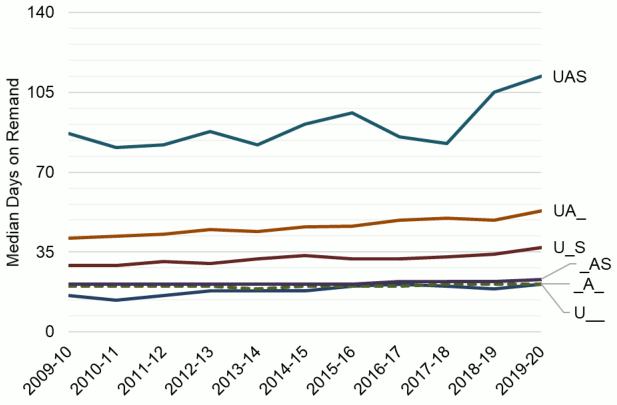
The chart illustrates a number of findings. Firstly, the journeys associated with the shortest median time on remand are ‘untried only’ (U__), ‘convicted awaiting sentence only’ (_A_), and ‘convicted awaiting sentence and sentenced’ (_AS). All three are associated with a median time on remand of just over 20 days. Those including time ‘awaiting sentence’ have been at a consistent level since 2009-10 but ‘untried only’ journeys have increased from a median of 16 days in 2009-10 to a median of 21 days in 2019-20.
On the other hand, journeys beginning as untried and transitioning to different legal statuses are longer and appear to be increasing in duration over time. The journey associated with the longest time on remand is ‘untried, awaiting sentence and sentenced’ (UAS). Between 2009-10 and 2017-18, the median number of days spent on remand for this journey type varied between 81 and 96 days. This rose to 105 days in 2018-19, and to 112 days by 2019-20.
‘Untried and awaiting sentence only’ (UA_) is the next longest journey type, and has been increasing in duration more consistently over time, the median number of days rising from 41 in 2009-10 to 53 in 2019-20. ‘Untried and sentenced only’ (U_S) has increased from a median of 29 days in 2009-10 to 37 days in 2019-20.
Relying on a measure of central tendency (i.e. median number of days) can mask the full distribution of time spent on remand. Figure 30 shows the time at which 90% of remand prisoners have departed or transitioned to the sentenced population is of a greater distance from the median for the transitioning untried journeys and the untried only journeys. Moreover, the number of days to reach 90% completion has grown faster than the median, particularly for the group spending time as untried. Across the different journey types, the growth in the number of days appears most pronounced from 2017-18 onwards:
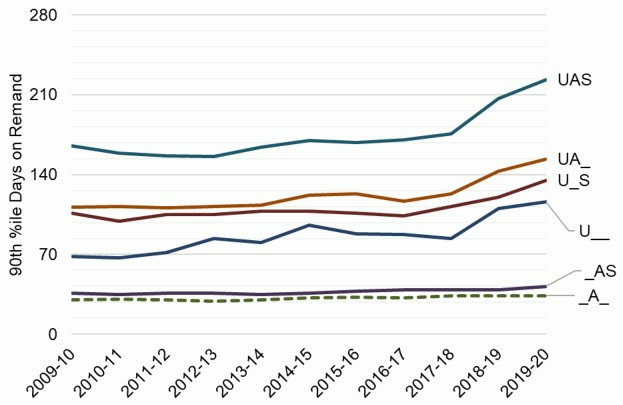
Exploring the distribution of time on remand in more detail, for those departing remand without transitioning into the sentenced population, there are clear peaks in the number of individuals spending specific numbers of days untried. These peaks appear to be largest at 1 and 7 days, followed by 14, 21, 28 and 35 days, as shown in Figure 31.
The number of journeys associated with the shortest stays on remand has been decreasing over time, as shown in Figure 31. For example there were around 400 stays of 7 days in 2019-20 compared with around 750 in 2009-10. The number of stays lasting 14 and 21 days also appear to be decreasing over time. Meanwhile, while 2009-10 and 2014-15 saw similar numbers of untried stays exceeding 120 days (140 and 135 respectively – around 2% of untried periods), this rose to 430 exceeding 120 days in 2019-20 (or around 9% of untried periods concluding in that year).
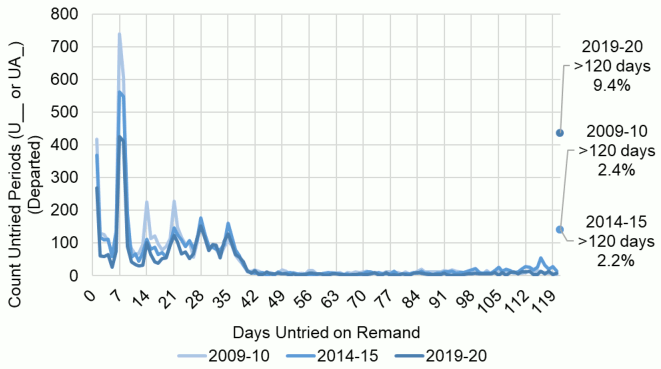
Looking more closely at times on remand, Table 3 shows that, overall, it took longer for individuals spending time untried to leave prison in 2019-20 than in 2009-10 or in 2014-15. For example, in 2009-10 72% of individuals had departed after 28 days held on remand but this had fallen to 61% in 2019-20.
| 2009-10 | 2014-15 | 2019-20 | ||||
|---|---|---|---|---|---|---|
| Total Departures (U__, UA_) | ||||||
| 6,384 | 5,960 | 4,625 | ||||
| Departed after… (cumulative by days) | ||||||
| 1 Day | 418 | 7% | 369 | 6% | 268 | 6% |
| 7 Days | 1,692 | 26% | 1,463 | 25% | 976 | 21% |
| 14 Days | 2,947 | 46% | 2,550 | 43% | 1,717 | 37% |
| 21 Days | 3,788 | 59% | 3,151 | 53% | 2,188 | 47% |
| 28 Days | 4,567 | 72% | 3,946 | 66% | 2,812 | 61% |
| 35 Days | 5,198 | 81% | 4,667 | 78% | 3,481 | 75% |
| 42 Days | 5,472 | 86% | 4,988 | 84% | 3,778 | 82% |
| Longer Stays (Count) | ||||||
| > 120 Days | 141 | 2.2% | 141 | 2.4% | 436 | 9.4% |
From around 40 days onwards, there is no clear weekly pattern. Those individuals staying longer than 5-6 weeks are spread over a wide range of longer durations. In 2019-20, around 9% exceeded 120 days on remand prior to their departure, up from around 2% in previous years.
Journeys that result in a transition from the remand to the sentenced population typically spend longer periods in remand than those journeys leading straight to a departure.
The distribution of days on remand for transition journeys (Figure 32) shows that the peaks observed at 1, 7, 14, 21, 28 and 35 days still exist, indicating that some transitions to the sentenced population happen relatively quickly. These peaks have also been shrinking in size between 2009-10 and 2019-20.
Overall, the tail of the distribution for transition journeys is longer in 2019-20 than in previous years, and a greater proportion of these journeys see a period of ‘untried’ of longer than 120 days, increasing from 6.7% in 2009-10 to 17.3% in 2019-20.
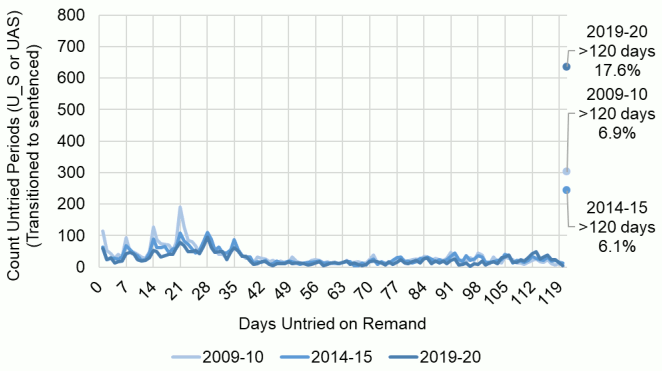
It is evident from Figure 32, and from Table 4, that a lower – and decreasing – proportion of transition journeys completed their time on remand within 5 or 6 weeks than for the departure journeys in Table 3. For example, in 2009-10 only 6.9% of transition journeys took more than 120 days to complete time on remand. By 2019-20 this had risen to 17.6% of journeys.
| Financial Year | 2009-10 | 2014-15 | 2019-20 | |||
|---|---|---|---|---|---|---|
| Total Transitions (U_S, UAS) | ||||||
| 4,403 | 3,983 | 3,612 | ||||
| Transition after… (cumulative) | ||||||
| 1 Day | 115 | 3% | 64 | 2% | 60 | 2% |
| 7 Days | 402 | 9% | 268 | 7% | 206 | 6% |
| 14 Days | 772 | 18% | 581 | 15% | 440 | 12% |
| 21 Days | 1,397 | 32% | 1,044 | 26% | 776 | 21% |
| 28 Days | 1,972 | 45% | 1,545 | 39% | 1,200 | 33% |
| 35 Days | 2,330 | 53% | 1,981 | 50% | 1,536 | 43% |
| 42 Days | 2,548 | 58% | 2,186 | 55% | 1,714 | 47% |
| Longer Stays (Count) | ||||||
| > 120 Days | 302 | 6.9% | 243 | 6.1% | 636 | 17.6% |
4.3 Liberation types
The previous publication provided information on the liberation reasons or ‘types’ recorded on the SPS prisoner records system. Here we break these down by legal status to explore differences between the remand and sentenced populations.
Note that the way that liberation descriptions have been combined has changed slightly for the purposes of this publication. See section Table 8 for further information.
4.3.1 Sentenced Departure Liberation Types
Table 5 provides details of the liberation types associated with departures from a sentenced legal status.
| Liberation Type | 2010-11 | 2011-12 | 2013-14 | 2014-15 | 2015-16 | 2016-17 | 2017-18 | 2018-19 | 2019-20 |
|---|---|---|---|---|---|---|---|---|---|
| Sentence Served | 8481 | 8473 | 8164 | 7494 | 7267 | 6687 | 6166 | 6246 | 6417 |
| On licence/Parole/ SRO/HDC | 2346 | 2427 | 2376 | 2359 | 2116 | 2116 | 2119 | 1524 | 851 |
| Court/PF | 298 | 216 | 264 | 258 | 258 | 241 | 260 | 321 | 327 |
| (Missing) | 178 | 188 | 144 | 129 | 156 | 147 | 137 | 205 | 189 |
| Immigration/ Deportation | 172 | 152 | 126 | 160 | 168 | 165 | 169 | 146 | 130 |
| Other | 215 | 168 | 182 | 151 | 120 | 145 | 107 | 117 | 105 |
| Bailed | 24 | 38 | 26 | 25 | 18 | * | 6 | 19 | 25 |
| Fine Paid | 49 | 22 | 18 | 27 | 18 | 25 | 17 | 16 | 25 |
| Appeal/Pardon | * | 5 | 10 | 9 | 8 | 8 | 18 | 13 | 9 |
| Grand Total | 11767 | 11689 | 11310 | 10612 | 10129 | 9537 | 8999 | 8607 | 8078 |
From 2010-11 to 2017-18, around 70% of sentenced liberations completed their sentence and were released, with between 20-24% released on license, parole, supervised release order (SRO) or Home Detention Curfew (HDC) in any given year. However, the proportion of conditional releases decreased to 17% in 2018-19 and to 11% in 2019-20. As a result, in 2019-20 the proportion of sentenced departures following completion of full sentence had risen to 79%.
In around 2% of sentenced releases, there was no associated liberation type due to missing data. In a minority of cases – 3-4% – a liberation type usually associated with remand departures are associated with sentenced departures. Court or Bailed liberation types for individuals released from a sentenced status might indicate that these individuals spent some time on remand directly following the completion of a sentence. This remand time would not be logged in the cellWise data build, as discussed in section 5.3.
4.3.2 Remand Departure Liberation Types
Table 6 provides details of the liberation types associated with departures from remand legal statuses.
| Liberation Type | 2010-11 | 2011-12 | 2013-14 | 2014-15 | 2015-16 | 2016-17 | 2017-18 | 2018-19 | 2019-20 |
|---|---|---|---|---|---|---|---|---|---|
| Court/PF | 7,532 | 7,847 | 7,078 | 7,159 | 6,807 | 6,274 | 5,680 | 5,420 | 5,830 |
| Bailed | 616 | 628 | 647 | 648 | 573 | 435 | 403 | 519 | 528 |
| Other | 40 | 39 | 37 | 52 | 49 | 45 | 51 | 60 | 60 |
| Immigration/ Deportation | 121 | 98 | 52 | 36 | 64 | 91 | 54 | 46 | 54 |
| (Missing) | 65 | 38 | 43 | 26 | 28 | 31 | 25 | 32 | 54 |
| Sentence Served | 49 | 59 | 35 | 52 | 40 | 28 | 35 | 21 | 12 |
| On licence/Parole/ SRO/HDC | 8 | * | 6 | 6 | 8 | * | * | 5 | * |
| Appeal/Pardon | * | * | * | 0 | * | * | * | * | * |
| Fine Paid | 0 | 0 | 0 | 0 | 0 | * | 0 | 0 | 0 |
| Total | 8,432 | 8,713 | 7,899 | 7,979 | 7,571 | 6,911 | 6,253 | 6,106 | 6,544 |
Remand departures are associated with ‘Court’ liberations in between 85% and 91% of cases since 2010-11 (89% in 2019-20). ‘Court’ liberations indicate that either: the individual is acquitted; the individual is admonished; the individual has received a non-custodial disposal for their offence when found guilty; or that the case has been dropped. The information provided to SPS when an individual is released from custody does not explain the full circumstances of each departure, so it is not possible to differentiate these outcomes using data from the prisoner records system alone. Further analysis linking the SPS derived data to the data held by other justice agencies would be required to establish specific outcomes.
A further 6-8% of departures relate to the individual being placed on bail after spending some time on remand (8.1% in 2019-20).
A small number of departures from remand are associated with sentenced liberation types: Sentence Served, On licence/Parole/SRO/HDC, Appeal/Pardon or Fine Paid. This indicates that there are some situations where a sentencing warrant has not been received by SPS, and we are potentially categorising these individuals as remand-only occupancy profiles in error. These amount to less than 1% of all remand departures each year, and only 0.3% in 2019-20. Departures from remand that can’t be associated with a liberation type make up a similar level – less than 1% – except in 2009-10 when they made up 4.9% of the total.
Contact
Email: jamie.robertson@gov.scot
There is a problem
Thanks for your feedback